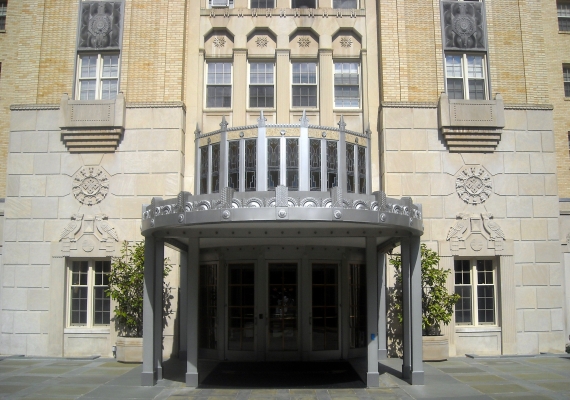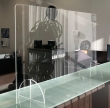Expert Checklist


Writer Barbara Ballinger recently spoke with Peter Di Natale about crucial renovation and repair strategies for hi-rise apartment buildings. This interview was conducted for one of the many real estate news websites that publishes Barbara’s work.
by Barbara Ballinger
The big bells and whistles in a multifamily dwelling often are the bait that attract residents, whether it's espresso bars, hip fitness equipment, Wi-Fi throughout the site, and even food trucks that park in the driveway as stomachs collectively growl.
But the day-to-day, weekly, monthly, and yearly maintenance and replacement needs are the infrastructure to keep existing tenants happy and renewing their leases, as well as attracting new residents to the property.
Exactly what maintenance should you schedule on a regular basis that will make a big difference? Individual apartments should be freshened when a tenant renews or moves out, which includes painting, re-carpeting, perhaps changing countertops and any appliances that no longer look their best or work well. Doing work on a preventive, regular basis offers another huge perk: You usually won't be scrambling to replace a conked out furnace in the dead of winter if you've been having it cleaned and serviced each fall. For the building's shared spaces, the following checklist of key chores will help make your building sparkle and remain up-to-date.
Remember that some are required, according to city or state guidelines. For example, in New York state, buildings that are six or more stories high must have their facades inspected every five years by licensed engineers to be sure no loose bricks or other building elements inadvertently fall on passersby. You may want to outsource to companies that specialize in certain jobs rather than tackle them yourself such as repairs and replacement of gym equipment or laundry appliances in shared facilities.
We talked with Peter Di Natale, President, Peter Di Natale & Associates, Inc., a full-service general contracting and management firm for multifamily residential and commercial buildings in New York, for more specifics and timetables. Here are his edited comments:
- Painting hallways and lobby. Every five to seven years, which may change if there's a building board and new members wanting to make their imprint. "When they start to look worn and paint starts to chip or wear off, or has an uneven sheen, it's time," DiNatale says.
- Re-carpeting hallways of individual floors and carpeted areas in shared spaces. Five years which is when carpet often starts to unravel and become a hazard for falls or tripping.
- Replacing lobby flooring, whether wood, stone, tile, or vinyl. If maintained properly, the replacement timetable for stone, tile, and wood, can be as long as 30 years. The life-span on vinyl is shorter, maybe, every 10 to 15 years. But if a wood floor is cleaned weekly, it can last, then be rescreened or polyurethaned every two to three years. Stone can be buffed every two to three years to remain looking good. And remember to put down mats when it's snowy or rainy, and have a front awning to protect residents' and their shoes and boots.
- Changing light fixtures, not just bulbs. Good quality fixtures can last, but you may want to change them because they've gone out of style. Some also aren't compatible with new LED bulbs. Most buildings don't tend to change the fixtures, however, until it's time to repaint.
- Cleaning and also replacing or upholstering furnishings. Good quality furnishings will last, but they should be kept clean on a regular basis.
- Hanging new artworks and decorative accessories to keep a building looking up-to-date. This also is usually another function of a building board's decision, or the owner or property manager, who may want to make a stylistic change.
- Repainting or tuckpointing the exterior and other cleaning work. Yearly inspections are important and have to be done in some cities and states. It's wise to plan to repaint certain parts of the building every two to three years, tuckpoint every five years or so, and clean limestone, which can get very dirty every 10 to 15 years, depending on pollution and climate (salt air can be tough on materials). Along with that, windows get dirty, and they should be cleaned once a season, or four times a year. If terraces exist, their railings should be inspected every year, along with balcony floors to be sure they can support a set weight and state that weight.
- Having downspouts, gutters, and other water-related features inspected and cleaned. Plan for inspections twice a year--in the fall when leaves are falling and in spring after trees flower; this way you avoid debris getting clogged and causing backups.
- Servicing and repairing a furnace, air conditioning system, and plumbing and piping. Here again a yearly inspection should be done for each: in early spring check the AC and change fluids or filters, and in the fall inspect the furnace and change filters.
- Inspecting and servicing elevators and sprinkler systems. In New York City, elevators have to be inspected yearly and sprinkler systems are checked by fire department officials. Know your city or state building guidelines to avoid fines or worse. Beside the safety features, consider upgrading your elevators every few years since floors take heavy abuse and may need to be changed. Also, be sure lighting is strong enough for safety, as well as cheerfulness when residents return home at night.
- Replanting outdoor lawn areas, and changing decorative floral arrangements inside. Every building wants to look its best, so if you invest and replant a small portion each year your building will look better and remain competitive. Most buildings change out seasonal arrangements regularly or rely on silk or dried arrangements inside. Some buildings contract out these services to a plant scape company or area florist.
- Replacing gym equipment, computers in a conference center, and laundry machines. Many companies outsource these services, too, upgrading equipment every few years when new models are available and technology changes.
- Updating safety features, from lock systems at the front door if no doorman to intercoms, video cameras, and exterior lighting. There's not a lot of turnover in this area, since these represent a big investment. Most buildings wait until they renovate their lobby. But one change that is happening more frequently is the replacement of the front door to make it stand out more, including the hip new bronze doors that are appearing at the front of many higher end designs. In the meantime, regularly check the door that hinges operate smoothly and door sweeps keep out cold and hot air.
- Replacing roofs and transforming them into usable space. Roofing materials can last for decades, but still should be inspected regularly, especially after bad storms for loose shingles or tiles. If possible, many buildings are turning them into outdoor space with furnishings and plantings. Because the elevator in most buildings doesn't extend to the roof, you'll need to be sure that a wide enough stairway with railing exists. Be sure, work is done that meets a city or community's building department guidelines. For example, you'll need a sturdy enough roof surface to support the weight of furnishings and plantings, and adequate railings to protect from falls.
Barbara Ballinger (www.barbaraballinger.com) is a freelance writer, author, and speaker who focuses on real estate, design, and family business. Her most recent book is Suddenly Single After 50: The Girlfriends’ Guide to Navigating Loss, Restoring Hope, and Rebuilding Your Life ( Rowman & Littlefield Publishers, July 2016)
What else do you find belongs on a regular maintenance and repair checklist? Please share your ideas with us on Facebook.











